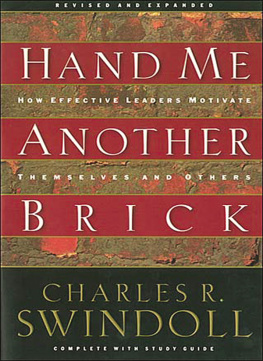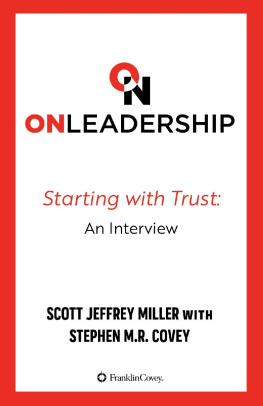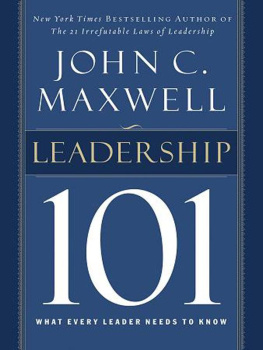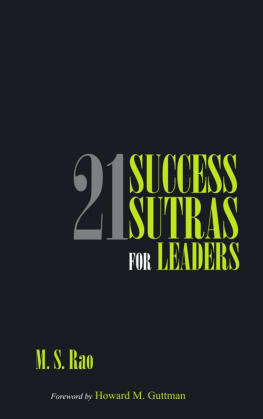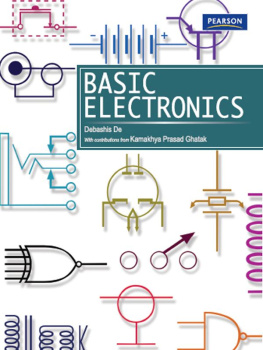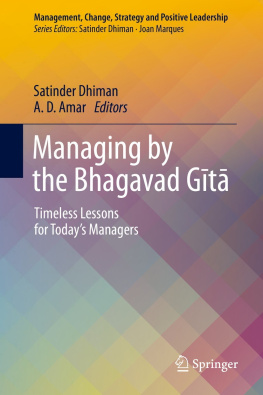Debashis Chatterjee - Timeless Leadership: 18 Leadership Sutras from the Bhagvad Gita
Here you can read online Debashis Chatterjee - Timeless Leadership: 18 Leadership Sutras from the Bhagvad Gita full text of the book (entire story) in english for free. Download pdf and epub, get meaning, cover and reviews about this ebook. year: 2016, publisher: Wiley India, genre: Religion. Description of the work, (preface) as well as reviews are available. Best literature library LitArk.com created for fans of good reading and offers a wide selection of genres:
Romance novel
Science fiction
Adventure
Detective
Science
History
Home and family
Prose
Art
Politics
Computer
Non-fiction
Religion
Business
Children
Humor
Choose a favorite category and find really read worthwhile books. Enjoy immersion in the world of imagination, feel the emotions of the characters or learn something new for yourself, make an fascinating discovery.
- Book:Timeless Leadership: 18 Leadership Sutras from the Bhagvad Gita
- Author:
- Publisher:Wiley India
- Genre:
- Year:2016
- Rating:4 / 5
- Favourites:Add to favourites
- Your mark:
- 80
- 1
- 2
- 3
- 4
- 5
Timeless Leadership: 18 Leadership Sutras from the Bhagvad Gita: summary, description and annotation
We offer to read an annotation, description, summary or preface (depends on what the author of the book "Timeless Leadership: 18 Leadership Sutras from the Bhagvad Gita" wrote himself). If you haven't found the necessary information about the book — write in the comments, we will try to find it.
Timeless Leadership: 18 Leadership Sutras from the Bhagvad Gita — read online for free the complete book (whole text) full work
Below is the text of the book, divided by pages. System saving the place of the last page read, allows you to conveniently read the book "Timeless Leadership: 18 Leadership Sutras from the Bhagvad Gita" online for free, without having to search again every time where you left off. Put a bookmark, and you can go to the page where you finished reading at any time.
Font size:
Interval:
Bookmark:

Copyright 2012 John Wiley & Sons Singapore Pte. Ltd.
Published in 2012 by John Wiley & Sons Singapore Pte. Ltd., 1 Fusionopolis Walk, #07-01, Solaris South Tower, Singapore 138628
All rights reserved. No part of this publication may be reproduced, stored in a retrieval system, or transmitted in any form or by any means, electronic, mechanical, photocopying, recording, scanning, or otherwise, except as expressly permitted by law, without either the prior written permission of the Publisher, or authorization through payment of the appropriate photocopy fee to the Copyright Clearance Center. Requests for permission should be addressed to the Publisher, John Wiley & Sons Singapore Pte. Ltd., 1 Fusionopolis Walk, #07-01, Solaris South Tower, Singapore 138628, tel: 6566438000, fax: 6566438008, e-mail: .
This publication is designed to provide accurate and authoritative information in regard to the subject matter covered. It is sold with the understanding that the Publisher is not engaged in rendering professional services. If professional advice or other expert assistance is required, the services of a competent professional person should be sought. Neither the author nor the Publisher is liable for any actions prompted or caused by the information presented in this book. Any views expressed herein are those of the author and do not represent the views of the organizations he works for.
Other Wiley Editorial Offices
John Wiley & Sons, 111 River Street, Hoboken, NJ 07030, USA
John Wiley & Sons, The Atrium, Southern Gate, Chichester, West Sussex, P019 8SQ, United Kingdom
John Wiley & Sons (Canada) Ltd., 5353 Dundas Street West, Suite 400, Toronto, Ontario, M9B 6HB, Canada
John Wiley & Sons (Australia) Ltd., 42 McDougall Street, Milton, Queensland 4064, Australia
Wiley-VCH, Boschstrasse 12, D-69469 Weinheim, Germany
ISBN 978-0-470-82427-6 (cloth)
ISBN 978-0-470-82925-7 (ePDF)
ISBN 978-0-470-82924-0 (Mobi)
ISBN 978-0-470-82926-4 (ePub)
This work is dedicated to Narayandas Chatterjee, who now resides in the timeless.
The Bhagavad Gita is a timeless text of about 700 verses. It is a spiritual classic that originated in India many years before Christ was born. The book appeared as an episode in the battle of Kurukshetra in Northern India. The Bhagavad Gita takes the form of a conversation between Krishna and Arjuna. The themes of the conversation range from the vast Cosmos to the innermost soul of a human being, often referred to as the Self.
Timeless Leadership weaves this battlefield conversation into a narrative on the problems faced by leaders such as Arjuna and the solution provided by Krishna from a perspective that is both compelling and contemporary. This conversation between Arjuna and Krishna is narrated by Sanjaya to the blind king Dhritarashtra, who is eager to know the outcome of the battle; thus the book is a narrative within a narrative.
The Dean of the Harvard Business School, Professor Nitin Nohria, in an informal conversation, described to me the relevance and message of the Gita in a way that cleared any doubt I had about the contemporary relevance of this text. He said, What Emerson is to America and Confucius is to China, Krishna is to India. I have known several Indian CEOs who have made it to the Fortune 100 list to echo the same feeling about Krishnas teachings to Arjuna. I trust this work is relevant for leaders around the world. I hope Krishna inspires leaders of all kinds to lead in their world in a way that makes the world a happier and a safer place for new generations.
This book is the result of a decade-long attempt to transcreate rather than translate the Gita for insights in leadership. The Gitas unrivalled status as a spiritual classic rendered in Sanskrit made this trans-creation a formidable task. A literal translation of the ancient text would create insurmountable roadblocks for todays readers. I have read through more than 200 interpretations of the Gita, ranging from people well-known in the western world, such as Gandhi, Emerson, and Thoreau, to revered authors from the Indian tradition, such as Swami Vivekananda, founder of the Ramakrishna Mission, and Swami Chinmayananda, founder of the Chinmaya Mission, and a wide variety of more contemporary authors.
From my research I have presented 18 sutras from the Gita. Each sutra serves as a cognitive unit or a chapter title that compresses the message of the whole chapter. The word sutra literally means a thread (as in a thread that weaves the beads of a necklace together) that combines different subthemes of a chapter as a unified whole. In well-known Indian texts such as the Yoga Sutra of Patanjali or Vatsayanas Kama Sutra, the word sutra denotes a short aphoristic statement that holds the attention of the reader or listener to the essence of the texts message. In Buddhist texts, the oral teachings of the Buddha were recorded in the form of sutras. This served as a device for the reader to memorize the text with greater ease.
The Sanskrit word sukta, which means well spoken or good news, according to some scholars has the same meaning conveyed by the word sutra. This has the same import as the word Gospel, which refers to Christs teachings. I have done the best I could to present the good news that Krishna delivers to Arjuna in the midst of the battlefield. I have taken the liberty to recreate the message of the Gita so as to make it more communicative to contemporary audiences around the world. In this, I believe, I have been able to glean 18 key messages of the Gita without diluting the core of its status as a sacred text. In short, I have not traded reverence for relevance.
The 18 sutras of the Bhagavad Gita have deep philosophical as well as practical implications for leaders of the third millennium. In this book, Krishna literally guides Arjuna and indeed all leaders like Arjuna through the ABCs of leadership. Here, A represents Authenticity or truth, which is the core value of leaders; B stands for Being, which is the raw material for becoming a leader; and C stands for Convergence, which a leader achieves between his current reality and his goal, or between a problem and its solution. Indeed, as a text, the Bhagavad Gita does not separate the problem from the solution. Arjuna, a leader-in-the-making, discovers the breakthrough solution to lifes most persistent problems in the midst of the battlefield. Corporate warriors and leaders who see themselves in this millennial march of evolution of humankind and human-centered organizations may find the message of the Gita truly life-changing.
Timeless Leadership will have served its purpose if the readers of this book find something of relevance to their life and work that is for them both timeless and timely.
This work is the outcome of diligent study and conversations on the Bhagavad Gita with many masters for over 10 years. It is impossible for anyone to read or write on the Gita without living some of it. The Gita is a timeless manual for the art of living. My father, Narayandas Chatterjee, was making some personal notes on his understanding of the Gita when he passed away in September 2009. It was a timeless aspiration that he nurtured in his heart and that even his death could not interrupt. Therefore, I lovingly dedicate this work to the son of my grandfather, Jatindramohan Chatterjee.
I wish to acknowledge my debt of gratitude to C.J. Hwu, Nick Melchior, and my editor, Emilie Herman, of Wiley, for their extraordinary patience in waiting for the manuscript, and to Professor Ted Malloch of Yale University, world-renowned author Professor Jagdish Sheth, Professor Raj Sisodia, Mr. N.R. Narayanamurthy of Infosysfor their encouraging comments. My heartfelt thanks to Mr. Nitish Jain for sending me on a paid sabbatical visit to Rishikesh to study with the ancient gurus who lived the Gita. I remember with love the contribution made by G Narayana, who initiated me into those austerities of life that helped me understand the Gita more than all the hundred-odd commentaries I read on the sacred text. I acknowledge my debt to my friend for many years, Prasad Kaipa, for finding a new interpretation for the acronym GPS in the mental and spiritual context; to Dr. Srikumar Rao, internationally known author and friend, for painstakingly reading the manuscript as well as introducing the notion of alternative reality into my mindspace. Special thanks to my executive assistant Mr. Sojan George and my research assistant Ramya, and to my colleagues and students in IIM, Kozhikode, for allowing me precious time off from my role as director of this great institution to find time for this book. Many of the ideas in the Gita have shaped my thoughts and our collective vision for the Institute.
Font size:
Interval:
Bookmark:
Similar books «Timeless Leadership: 18 Leadership Sutras from the Bhagvad Gita»
Look at similar books to Timeless Leadership: 18 Leadership Sutras from the Bhagvad Gita. We have selected literature similar in name and meaning in the hope of providing readers with more options to find new, interesting, not yet read works.
Discussion, reviews of the book Timeless Leadership: 18 Leadership Sutras from the Bhagvad Gita and just readers' own opinions. Leave your comments, write what you think about the work, its meaning or the main characters. Specify what exactly you liked and what you didn't like, and why you think so.


